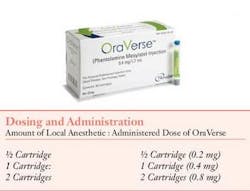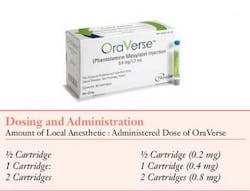Infiltrating the block
by Tricia Osuna, RDH, BS, FAADH
[email protected]
In today’s dental world, where we rapidly accept new technologies, we often find ourselves presented with products that boggle our minds and cause us to ask, “How did that happen?” Once we open our minds to the new technologies, the next step is integrating them into our patient treatments. Some of these technologies allow us to save a lot of time. Since many patients lead overly busy lives, we may be pressured to provide treatment that’s not our first choice due to “patient direction” related to their time constraints.
Because dental hygienists are increasingly allowed to administer local anesthesia (LA) (according to the American Dental Hygienists’ Association, 41 states as of 2009), there is an increase in total administration of local anesthesia in the practice of dentistry. This increase in LA has many patients concerned about returning to their workplace following dental treatment with the perceived discomfort of anesthesia and its aftereffects. I recently had a patient that was not interested in LA, but wanted to get through the scaling of a few sensitive teeth without the “drooped face look.” As we provide increased patient comfort in our delivery of dental hygiene, it’s useful to understand our options. OraVerse™ from Novalar Pharmaceuticals, Inc., offers something that will help increase patient acceptance of LA.
OraVerse is the first LA reversal agent on the market. The product, launched in February 2009, is a vasodilator comprised of phentolamine mesylate, a nonselective alpha-adrenergic blocking agent. The use of OraVerse decreases the time a patient loses sensation from LA. The indications for use of OraVerse are for reversal of soft-tissue anesthesia, and the associated functional deficits resulting from an intraoral submucosal injection of a local anesthetic containing a vasoconstrictor.
Young children or special needs patients are now being provided a safer return to normalcy that alleviates cheek or tongue biting. Adult clients are able to return to comfort and normalcy, while avoiding the “drooped face look.” Many of us remember the Bill Cosby skit where he’s a dental patient that has trouble speaking, but has no problem with the infamous drool of saliva. There’s no better or funnier way to show what can enter patients’ minds when they think about anesthesia during dental treatment.
Marketed in green color-coded cartridges, OraVerse is administered with a standard dental syringe and needle. Adult dosage is one cartridge of OraVerse per one cartridge of local anesthetic, with a maximum dosage of two cartridges of OraVerse per patient. In children ages 6 to 11 that weigh 33 pounds or more, maximum dosage is one cartridge, while children between 15 and 30 pounds should receive one half of a cartridge. OraVerse™ clinical trials resulted in the recommended use of the reversal agent in patients ages six and older.
As I continue my clinical practice, I’m in awe of how far the profession has come, and the products that are available to us intrigue me. Now we need to integrate these technologies for improved patient care.
About the Author
Tricia Osuna, RDH, BS, FAADH, is a USC graduate and current president of the American Academy of Dental Hygiene. With over 30 years of experience as a dental hygienist, Tricia shares enlightening and participatory presentations with her audiences. Osuna is a lifelong CDHA/ADHA member and a previous member of the Dental Board of California. Licensed in both California and New York, her career spans a variety of roles in dental hygiene, including clinician, consultant, educator, author, and mentor, as well as business owner and president of Professional Insights, Inc. Contact her at [email protected].

